Who Sings on the Road Again Bass Clef Notes
Throughout the Beatles' 8 years of recorded content, the band reinvented songwriting and demonstrated a tremendous breadth of musical inventiveness during such a short period of time. The band recorded everything from show tunes to ballads, songs inspired by Motown, songs inspired by the birth of stone in the 1950s, ballads, blues pieces, R&B to encephalon-twisting psychedelic, and even more all while blazing the path for with new recording techniques and pushing the envelope for what was possible in to record in the studio.
Over all these musical changes, Paul McCartney adapted and showed his ability to create some of the gold-standards of bass playing regardless of what the song could be boxed into every bit a genre. McCartney could play simple root and fifth lines similar on "Dear Me Do," "From Me to You," and "I After 909", rock 'n' coil eighth notes like on "I Saw Her Standing There," "Long Alpine Sally," and "Little Child", bass lines that pushed the song forward similar on "Go Back," "Everybody's Got Something to Hide Except Me and My Monkey," and "I'thou Downwards", short repetitive grooves "Taxman," "Dr. Robert," and "Come Together", and even fast and flashy lines ("Rain," "Paperback Writer," "I Want Yous (She'southward So Heavy)").
But Paul was probably known best for his ability to arts and crafts melodic bass lines or bass lines that move through the chord changes rather than alter with them as they come and works to shine over the unabridged song. Using arpeggios and scalar passages, McCartney was among the first bass players in the forefront of modernistic rock music to
Of course, Paul McCartney was a natural melodist, having written some of the nigh memorable songs in the history of popular music. In this commodity, we'll look at a few of McCartney's well-nigh melodic electric bass passages and focus on some common patterns that he used to connect chords.
Here'southward a breakdown of xx of the quintessential Paul McCartney bass lines:
1. "Taxman" – Revolver (1966)
If there was a more recognizable Beatles bass line, it can't beat out "Taxman".
McCartney'due south bass work hither is very straightforward but very singled-out and certainly can be argued to be the melodic chemical element of the song. Equally George and John alternate between downstroke guitars on beats two and four throughout the verse, chorus and guitar solo sections, McCartney is keeping to the mid-to-upper register of the bass guitar to build out this bass line.
The nearly interesting aspect of this bass line is it'south simplicity. The line'southward start pattern begins first on the chord's root note D on the 5th fret and jumps to the octave D on the 7th fret on the G string. Then, it incorporates a hammer on on the D string from Grand to A and resolves back towards the high C.
This design is held until McCartney drops it downwardly to start on A natural on the corus and then down lower to begin on the G for the 2d part of the chorus.
While McCartney'south root notes stay in line with the chord changes of the vocal, the pattern of notes and bass line's rhythm stay consequent wherever Paul is playing the line on the neck.
2. "Something" – Abbey Road (1969)
Few bass lines best capture McCartney'south melodic style of playing than the line played on "Something" off the Beatles' 1969 release, Abbey Road.
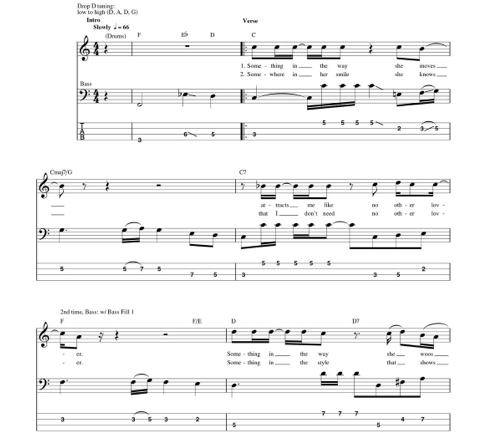
This beginning figure (left) outlines a department of the verse and the bass line McCartney plays on it.
Immediately, someone looking to learn this line can come across that the bass very frequently completes the vocal melody and the spaces where the guitar playing is at information technology's least. All-time shown on measure 3, measure 5 but before "Something in the manner…", measure 7 and 8to proper noun a few sections.
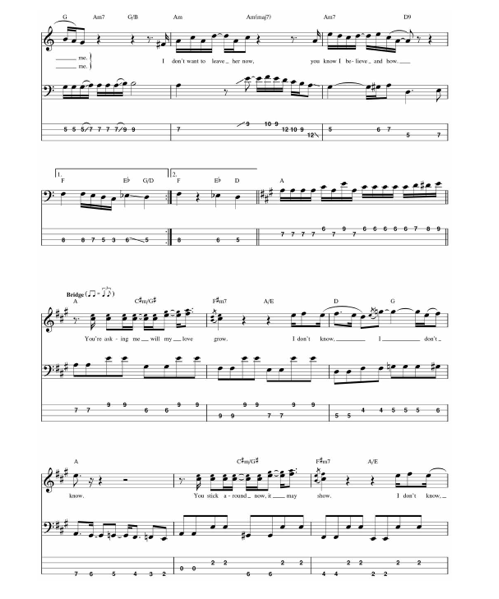
In the verses of "Something", Paul focuses his work on completing and complimenting the endings of Harrison's passages. Every 2-4 confined, McCartney is right there usually with a very distinct 16th note run to punctuate the phrase or with a half or quarter note series that sounds and resonates distinctly differently from the delicate comping guitars of Harrison and Lennon.
Moreover, Paul tends to begin his bass lines on the root notes of the chords being played only winds through the chord into the side by side one.
It'due south this quality that makes a McCartney bass line so distinct: his ability to air current and weave through chords both by combining notation pick with rhythmic distinction from the residue of the instruments playing. Moreover, it's a theme that I'll refer dorsum to over the course of this postal service because the trait is but that apparent.
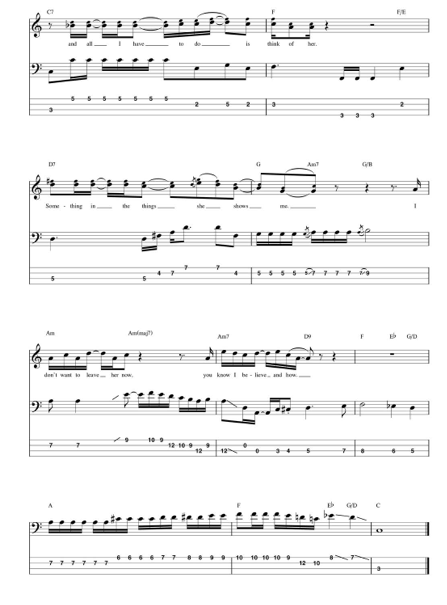
The bridge of "Something" is peculiarly interesting from a listener's standpoint besides as from an observational perspective when looking at the sheet music.
The showtime thing that stands out is just how busy the bass line is compared to the guitar piece of work. The bridge is a fantastic instance of Paul taking the musical lead with the bass while nevertheless moving in footstep with the chord progression created by Harrison.
Whats more than, McCartney is very generous with accents and annunciations during the span. Slides, hammer-ons and drops and jumps from i octave to another are very common here and merely add to the lead qualities mentioned earlier.
Equally Harrison'south vocals soar and reach a climax before inbound the guitar solo, McCartney is correct there behind him with a scalar run of 16th notes (see the terminal three measures above) before dropping off with a depression C – a musical catamenia on this department of "Something" considering of information technology'due south distinctness from the residual of the bass line upwardly to this signal and from a song structure stand point. The bridge is now over – time to enter the guitar solo.
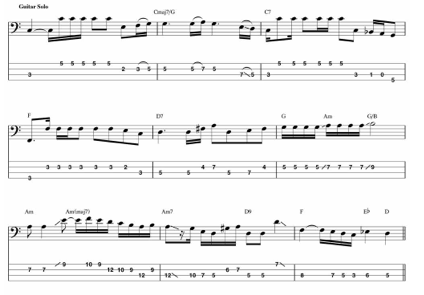
The last major point is the guitar solo of the song through to the cease.
McCartney revisits the bass theme established during the verse but this time with a few variations including using more than scalar runs to connect chords and bars together. A good example of this is the 7th measure out of the guitar solo section (see right) where beats 3 and iv are connected by a series of 16th notes running down an East modest scale across an Amjr7 chord back into an Am chord in the adjacent bar.
3. "While My Guitar Gently Weeps" – The White Album (1968)
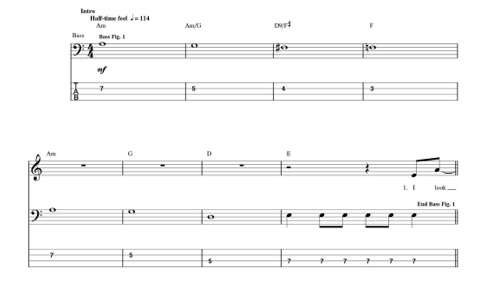
Unlike McCartney's work on "Something", Paul'southward bass work on George Harrison'due south archetype, "While My Guitar Gently Weeps" takes on more of a "traditional" bass guitar part, aimed at providing bottom end and structural support to Harrison'southward song.
The introduction of "While My Guitar Gently Weeps" showcases Harrison'due south guitar piece of work while McCartney provides whole notes
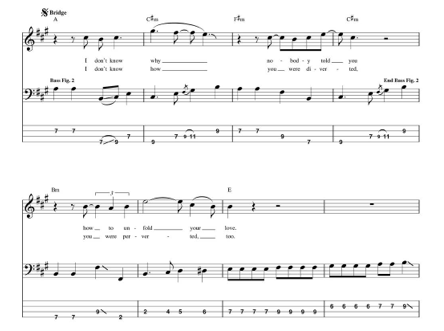
McCartney's playing is showcased most during the bridge of this song. While the sounds of a Hammond organ provide a background of chords behind Harrison'southward singing, McCartney meshes aspects of a walking bass line together with slides and accent patterns to continue to give the song a forward moving feeling with a scrap of weight to it.
Listening the recording, the well-nigh stand-out notes that McCartney plays during the bridge section are in the first measure of the bridge where Paul will leap downwardly from the loftier A to the B natural and build back upwardly the scale starting at B to A, so to E, back down to A and build back up across the first 2 measures of the section.
This pattern re-emerges on in the fifth bar when on beats one and two, Paul starts on a B natural, jump to an F on beat 3 and slides down to D on crush iv and rebuilds back up through bar 6 then resolves then entire passage beyond bars seven and 8 and leads into the verse (below) where Paul returns to rhythmic playing.
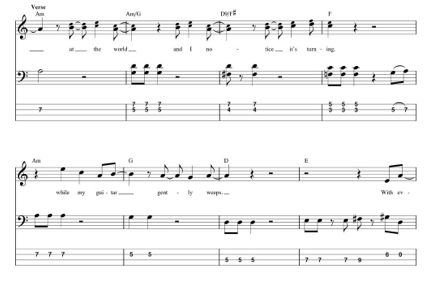
Paul'due south playing on "While My Guitar" sticks to filling a supportive part rather than a melodic role.
The pattern to the left is the theme consequent throughout the verse: accented playing on beats 1 and two of each bar and a turnaround on bar eight.
Though at that place are variations on this theme as the verse progresses for it's full duration, this theme re-emerges as well during Harrison's showtime guitar solo and on the outro guitar solos besides (both figures below):
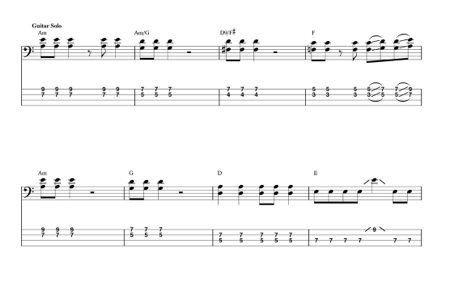
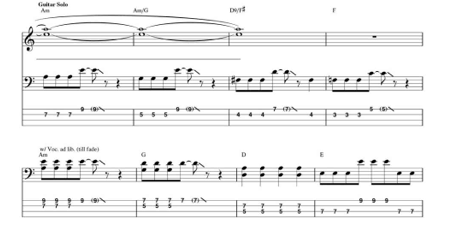
The song, every bit whole is an excellent showcase of Paul McCartney'south more supportive role every bit a bass histrion rather than every bit a melodic, lead. A part – as we'll see throughout this analysis – that he tin can perform just as well as well every bit when he is taking the lead.
4. "Come Together" – Abbey Road (1969)
But as recognizable as "Taxman", "Come Together" is some other instance of a uncomplicated all the same incredibly hook-y Paul McCartney bass line. Though some argue that this was his best bass line (but at the end of the twenty-four hours, everyone has a "best Paul McCartney bass line" they can betoken to), this line is certainly ane of the more memorable and a great learning tool for a beginner bass role player.
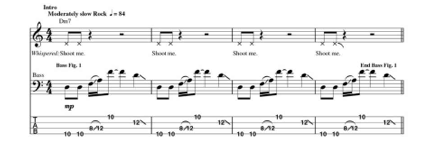
Like "Taxman", Paul'due south bass line for "Come Together" follows 1 primary theme (that doo-do-doda-bwahh-doo) that he establishes inside the first 4 confined of the song (left)
The song instantly hooks your ear because of all the contrast going on. What practise I hateful?
- The number of notes being played in the phrase. Guitars are largely absent and Ringo'south drum part is very minimal – hullo hats and low-cal percussion only. Meanwhile, Paul is playing in the upper register of the bass AND working in a (relatively speaking) decorated bass line
- The number of accents. Tying into the last bullet bespeak, Paul'due south employ of accents hither – slides and hammer ons in particular – further distinguish the line from the rest of the song in conjunction with the points made from the bullet point higher up.
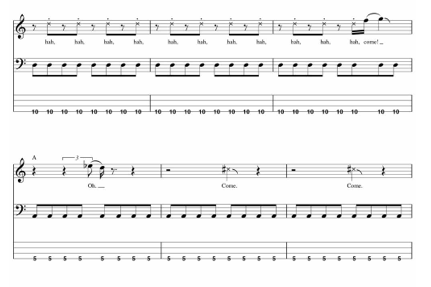
The chorus here is a classic example of a catchy sing along chorus that the music supports wholeheartedly from the all musical instrument arrangements.
Paul's bass line hither is simply as straightforward and complimentary: pedaling eighth notes that motility in lock-step with the chord changes.
The line here is simple yet functional and designed to be gratuitous and rhythmic rather than melodic and independent.
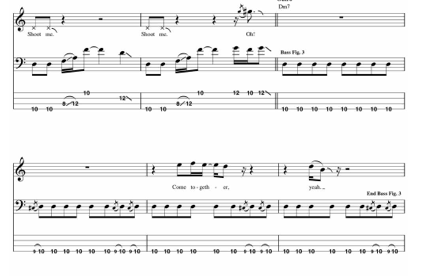
The outro of "Come Together" marries the theme from the intro and verse with the theme from the chorus with a small variation: the inclusion of hammer ons through to the finish of the vocal.
The hammer ons in this case add the aforementioned qualities that the accents and note jumps made in the primary theme of the song: to add a distinguishable quality from the guitar lines to the bass line.
5. "Hello, Adieu" – Magical Mystery Bout (1967)
"Hullo Goodbye" is a Beatles song off their 1967 album, Magical Mystery Tour. The song itself marries a whimsical song writing style characteristic of the mid-1960s Lennon/McCartney writing style besides as elements of "simple song" writing of the 1950s love songs and Beach Boys pieces.
"Hello Cheerio" is a great instance of a McCartney bass line that picks upward steam in select areas of the the song for brief periods of time. Rather than an entire theme being the center bespeak of, say, the poesy or the span, it's 4 bar runs that make the song a noteworthy piece in this listing.
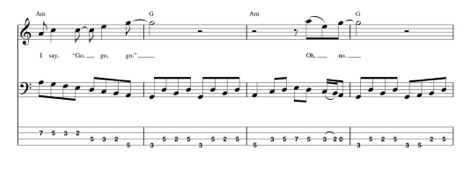
The instance that I'm referring to are the last five bars of the poesy section of the song, where Ringo begins to outline the backbeat of the song before leading into the chorus ("How-do-you-do, hello, I don't know…")
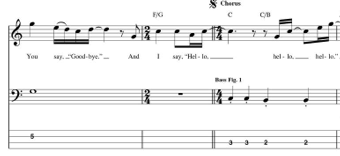
These 5 bars are the bars that drive the song in and out of the chorus and give the vocal itself a very distinct feeling of motion for a brusk period of time.
Before and afterwards this function, the song takes on a very carefree and floating quality supported by Lennon's characteristically airy vocals, a mid-range piano hammering eighth notes and Paul's bass line only serving root functions through a quasi-walking bass line and parts that conclude the musical passage every four or 6 confined.
I say quasi-walking bass line because the bass line itself does non stay a walking bass line for more than a few bars at a time before breaking to hold for a whole note or to make a curt eighth note run to – again – resolve the musical passage (beneath):
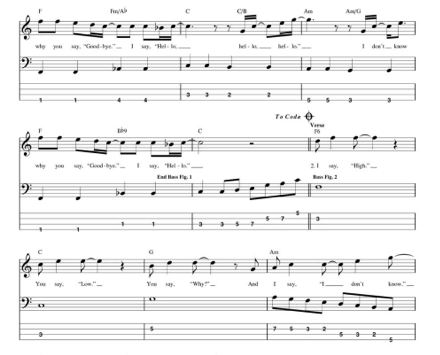
half-dozen. "Happiness Is A Warm Gun" – The White Anthology (1968)
Jeez – what a song this one is!
"Happiness is a Warm Gun" off the Beatles' 1969 self titled double anthology (affectionately chosen, The White Album) is on this listing but for the reason that this vocal is the best example in the entire Beatles catalog of playing a melodic bass line through a boundless array of very irregular time changes.
If ever there was a better crash form in reading and counting rapid time signature changes than this song, I can't recollect of one.
Hither's a short overview of exactly how many time signature changes go on over the course of this song courtesy of the Beatles Bible:
- 4 bars of 4/4
- 1 bar of four/iv
- 1 bar of two/iv
- 5 bars of 4/4
- 1 bar of v/4
- 1 bar of 4/4.
- 22 bars of 3/8)
- Three times through a bar each of nine/viii and x/eight
- four bars of four/4
- 3 confined of 12/eight (with the drums doing iv bars of 4/4 and 1 bar of 2/4)
- 5 bars of 4/4 (the last bar entering complimentary time)
- 1 bar of 2/4 (in gratuitous time)
- v bars of iv/four
Wow…
I'll requite you a minute to check out all those time changes ane more than time.
In one vocal, the Beatles gave the entire progressive rock movement of the 1970s a run for their money.

Inside the first 8 bars of the song, there is already a fourth dimension signature change from 2/four to 4/four – specifically on confined six and vii (pictured above). Though the bass line appears challenging, Paul is simply playing quarter notes across the chord changes of D small (non shown – merely happens ane bar earlier the change to 2/4) and Am, starting time on the root annotation and so moving down a perfect 4th in measure 6 and measure seven, and so moving support a quaternary to the A.
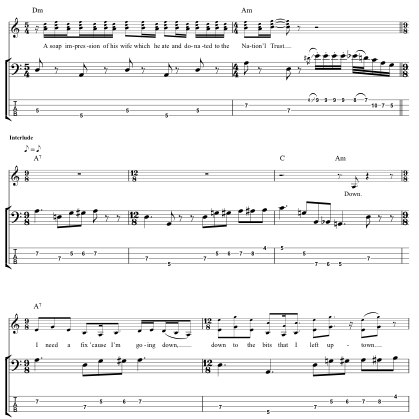
This next excerpt is only 2 more confined into the vocal from the last excerpt. Like the passage earlier, Paul's bass line is providing more of a framework to keep time with rather than to create a melodic tool with.
McCartney is returning to using walking bass line qualities beginning on the root notation of the bar's chord and merely using a scattering of notes each time the time changes to a signature too irregular to become melodic or counter melodic with.
Even when the time changes once more from a quarter note based experience (5/four, 4/four) into an 8th note based feel (six/8, 7/8, 9/8), McCartney'due south bass playing stays uncharacteristically controlled, only outlining the downbeats dictated by the time signature, the root note of the chord and merely small scalar steps across 3rds and 5ths.
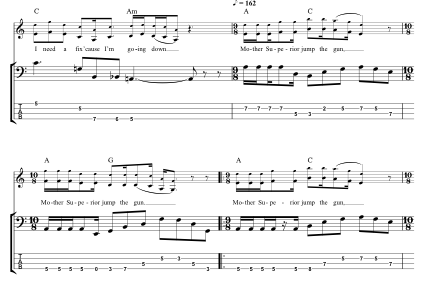
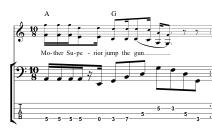
The following passages highlight the dorsum-and-forth between 10/8 and ix/8.
*Before we go any further – a quick counting lesson: 2 16th notes have the same duration every bit 1 eighth annotation.
With the first pattern of 9/8, Paul begins playing on an A earlier dropping down a 5th to the D and then building back upwardly the B major scale into the 10/viii bar.
Transitioning to the bar of ten/8 signifies the addition of only 1 eighth note. This is reflected by McCartney'southward bass line in these 10/8 confined by playing the exact same bass line as 9/8 but with the addition of the low Thou at the end of the 10/8 bar (meet both bars of x/viii)

The last major section of this song is the chorus where the band returns back to 12/eight time which is another way of counting four/4.
*Quick counting lesson once again! A quarter has the value of 2 eighth notes. So when looking at this bass line and we see a quarter note and an eighth residuum, it's counted ane-2-3, ane-2-3, 1-2-3, 1-2-three | 1-2-3, etc. In other words 12/viii has four groupings of three eighth notes.
Bearing this counting lesson in mind, Paul'south bass line doesn't seem and then cryptic.
7. "Lucy In the Sky With Diamonds" –Sgt. Pepper'south Solitary Hearts Club Band (1967)
The archetype psychedelic ballsy inspired by a immature girl that John Lennon also comes with a bass line that mirrors something Carol Kaye would have come up upwardly with.
In the verse of this song, McCartney lays down a foundation of half and whole notes underneath Lennon and George Harrison'south guitar work:
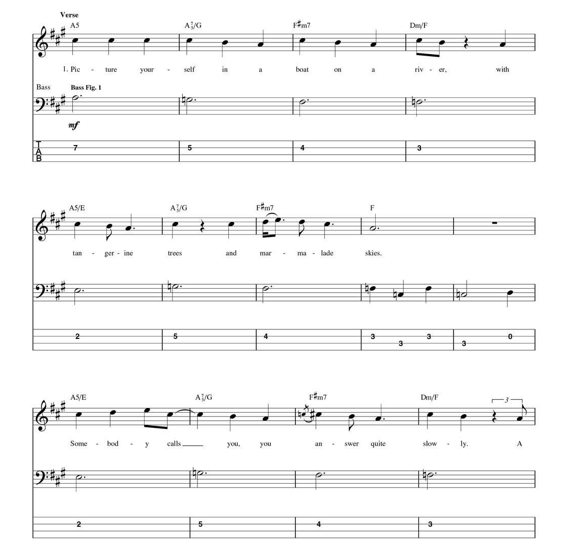
The chord progression is rather straight forward from the perspective of Lennon and Harrison's playing, and to a certain extent, as is McCartney's bass playing.
Through most of these runs, Paul is playing root notes and following along with the guitar role.
It's not until the pre-chorus does Paul whip out a textbook example of a walking bass line.
As the guitar parts and Star's snare match the chugging, predictable experience of the chorus, Paul is weaving through the chords and through the eighth notes with a walking bass line:
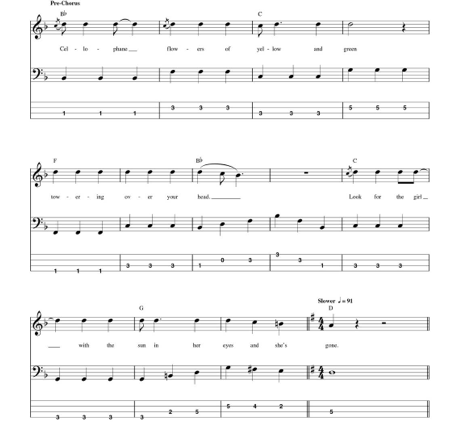 As the song itself builds, then does the complication of Paul'due south bass playing.
As the song itself builds, then does the complication of Paul'due south bass playing.
As the chrorus unveils and the cymbals are crashing and Lennon is singing, "Lucy in the sky with diamonds/Lucy in the sky with diamonds", Paul is edifice off of the walking bass line established in the pre-chorus and calculation additional "in-between" notes to make it both through the chord progression and from one note to the adjacent, all while providing the melody for the chorus as the guitars provide the rhythm.
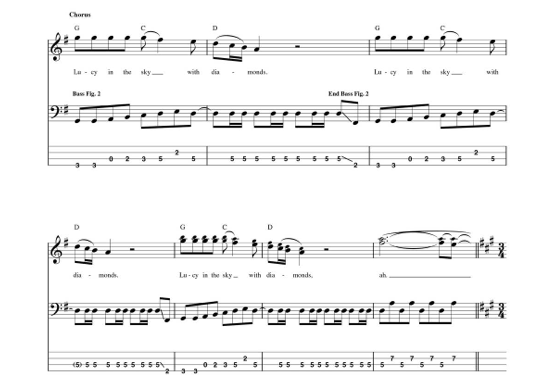
McCartney is very clearly taking advantage of the rests of the guitars on beats 3 and 4 and taking the opportunity to make full those breaks with additional rhythmic support in the form of root notes, scalar runs, slides and bouncing between the root and 5th notation of the chord existence laid out by Harrison and Lennon.
viii. "Hey Bulldog" – Yellow Submarine (1968)
A personal favorite to play, "Hey Bulldog" came out on the 1968 release, Yellow Submarine. This song made information technology to the listing because of the "not-stop-playing" quality of this bass line.
Few McCartney bass lines go on the entire song with few to no rests and this is one of those examples.

Similar many of the songs on this listing, a major theme or hook is established within the offset 4-eight confined of the song, but dissimilar other Beatles songs mentioned on this list, the introduction of this song establishes gradually builds over the form of vi bars rather than just repeating in full system. McCartney joins in the theme during the last vi confined (above)
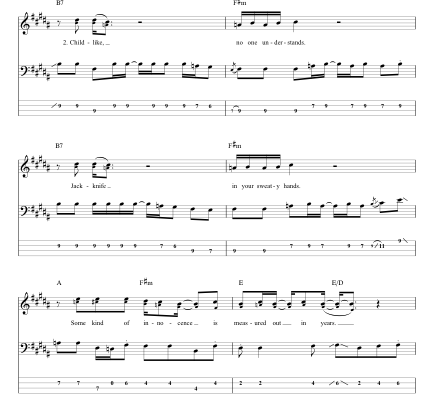
What's besides interesting about McCartney's piece of work on this song is that the bass line seldom stops to rest. The bass line continues throughout the song arguably being the sole cistron giving the song it's bouncy simply moving quality with a combination of eighth note and 16th note runs upward and downward the chord progression outlined by Lennon and Harrison.
McCartney's bass line also is unique during the verse sections for it's ability to play either in lock step with the 8th note pianoforte in the background of the song and Ringo's hi chapeau or play in-between them with short 16th note runs, best outlined in each of the measures presented in the excerpt above.
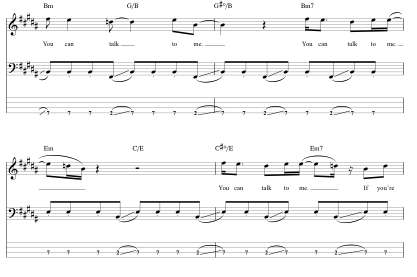
The chorus department (left) is distinct from the remainder of the song considering of the use of a express set of notes and the incorporation of slides to motility up and downwards from the depression and middle sections of the bass.
During the guitar solos and the outro portions of the song, McCartney revisits playing patterns that were established earlier in the song'southward verses sections. Like before, the bass lines provide a strong rhythmic undercurrent to the song while Harrison's guitar solo takes place and while the final chorus of the song is existence sung taking the song to the conclusion.
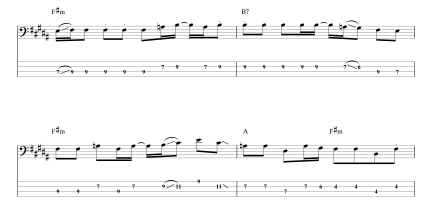
9. "Rain" – single
"Rain" was a single released by the Beatles in 1966 equally the B-side to "Paperback Author", the leading unmarried off the ring'south 1965 release, Rubber Soul. "Rain" was also one of the first Beatles singles to receive a promotional video release with the vocal.

It'due south of import to run across that "Pelting" is just based off of four chords:
- Grand major
- Csus2
- D7sus4
- Gsus4
- Cmaj9
- G7sus4
The latter 4 chords of this song but appear towards the bridge and last chorus briefly. For the most part, the vocal is based off of 2 chords: G major and Csus2.
Why did I bring this detail upward?
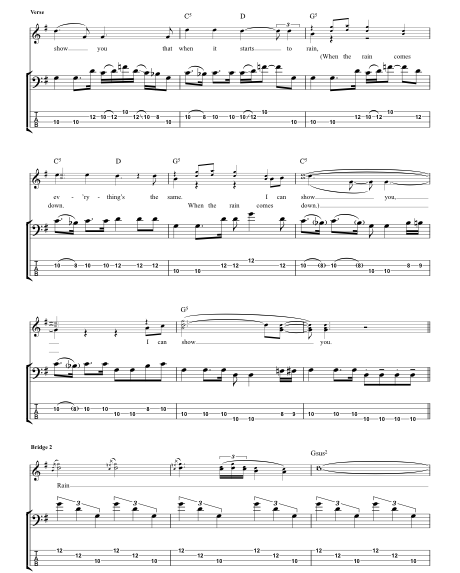
Because these few (and seemingly bizarre, sonically "incomplete-sounding" chords) are what, first, set the sonic properties for "Rain" and are what help to make Paul's bass line pop even more.
While the bass line begins each of it's patterns on each of the root notes of the chord, it helps to observe that the vocal tune and the guitar parts are very sparse, very staggered and very winding and psychedelic compared to the bass line which is very flowing in a predictable up-and-down pattern both outlined by how the notes are arranged and how the line actually sounds within the context of the song.
The other portion of this rail worth noting is the bridge section. Paul changes up his playing significantly from the theme he established back during the verse, chorus and introduction.
While John, Paul and George all harmonize the give-and-take pelting and continue to strum G and C chords, Paul is hammering F onto G, harmonizing his bass an octave in a higher place the root note of the M when John and George are playing the G major and Gsus4 chord. Moreover, when the chord progression moves through the D and the C major chords (not shown in this excerpt), Paul continues to hammer the high G which ends up harmonizing the perfect 4th of the D chord and the perfect 5th of the C chord.
Notwithstanding another of Sir Paul figuring it all out and playing what a peachy bass thespian does: what fits and what works for the song.

10. "And Your Bird Can Sing" – Revolver (1966)
"And Your Bird Can Sing" is the last song on this Paul McCartney bass line roundup.
This song was runway number ix on the Beatles' showtime major step into the realm of psychedelic and world music with their 1966 album, Revolver.

The introduction of this song hits you with total force: a ii pronged attack of the chief theme (after to exist revisited during the chorus section) played in unison by Harrison and Lennon while McCartney plays countermelody underneath (pictured above). To give a little bit more perspective how Paul's bass line looks and fits with regard to the descending guitar line, here'due south what Lennon and Harrison are playing:

Paul'due south bass line, compared to the guitar line, is significantly less linear and less scalar than the guitar part, but joins the guitars on the eighth notes on beats 3 and iv in confined ane and ii.
Lining up each of these eighth notes together creates a very interesting countermelody/melody relationship. Both passages first on a B natural but and so split up like this:
Bar one – Beat 3 and 4
Bass: B – B – D natural – D precipitous
Guitar: F – E – D – E
Bar 2 – Beat iii and four:
Bass: B – A – D natural – D precipitous
Guitar: G – D – E – F
Bearing in listen that this song is in the key of E (four sharps; F#, Grand#, C# and D#), and the chord over McCartney, Lennon and Harrison'southward parts is an E major chord ways that McCartney's bass line harmonizes the perfect fifth, minor 7 and dominant 7th on beats 3 and 4 of the E major chord while the guitars harmonize the minor 2nd, root, minor seventh and root during bar ane and and the modest 3rd, small-scale seventh, root and modest second during bar 2.
Ever wonder why the intro to this song sounds to exciting and in-your-face with sound and texture? That's why.
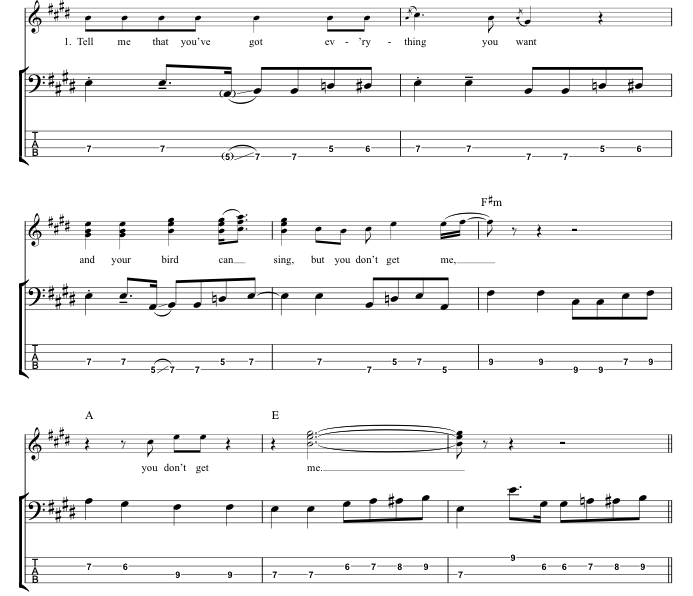
During the verse section, McCartney switches to a quasi-walking bass line,reminiscent of what we touched on during the breakdown of "Hullo, Goodbye" to a higher place. Either a quarter note passage will fill the space on beats 1 and 2 like in measures 2, five and seven of the above extract followed past eighth notes on beats three and 4 on the same measures. Other times, McCartney volition just play a quarter annotation on the downbeat of beat 1 usually the root note of the chord followed by a a dotted eighth notation-16th note tie into the downbeat of beat out iii like in measures one and three or one without a necktie.
The exception to all of this is mensurate six where the unabridged bar is a decending scalar quarter note run starting on the A. Listening to the track, this is the office that sticks out clearly and the part that most people volition hear without having to actively mind to the track.
Why does this stand out?
Check out the measure out. Notice the rests that are in that mensurate and how much space is left open up for the bass to make full. Rather than fill it with a busy flurry of 16th notes that might have jeaprodized the movement and overall feel of the vocal, McCartney chose to go along with steady, walking quarter notes that fulfill the melodic elements of the song equally a whole as well as the melodic elements of this detail part of the song. Smart move.
Conclusion
Whew! So that wraps up my get-go breakdown of a bass actor's (arguably) some of the all-time bass lines of Paul McCartney.
What did we get from this? Well, McCartney was a pretty smart guy when information technology came to bass playing. His playing style could best be characterized as melodic, colorful, driving and costless. Information technology harkens back to the playing styles of session greats like Carol Kaye and James Jamerson and other RnB bass players who were popular in the United States during the 1950s and 1960s.
Some of Paul's playing is deceptively challenging. "Happiness is a Warm Gun" is a great example of the secret challenge that lies beneath
– – –
Now I want to hear from you lot!
What did you think? What did I miss? What did I get wrong? Should I practice this kind of post again for another bass role player?
Shoot me an electronic mail at [electronic mail protected]
What do you lot think is a must-know Paul McCartney bass line?
Source: https://smartbassguitar.com/must-know-paul-mccartney-bass-lines/